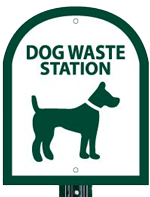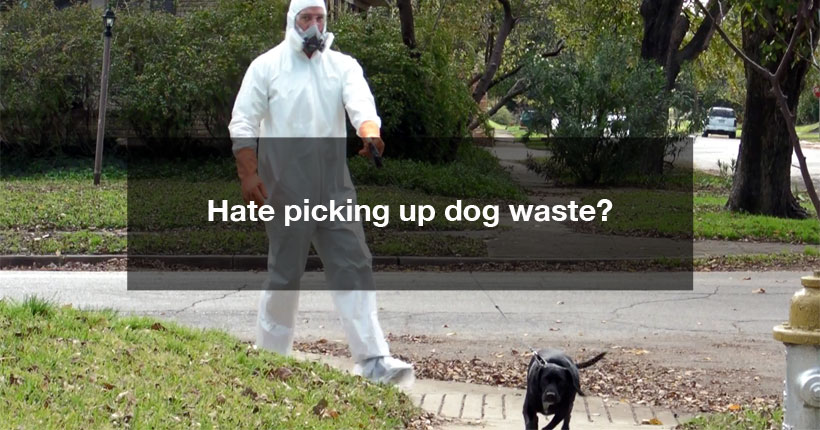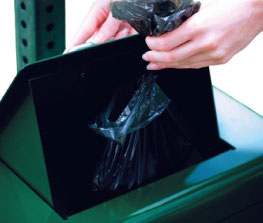Community-Awareness Campaign

How to Get Your Community
to Pick Up After Their Dogs
How do you get dog owners to pick up their dog's poop? Answer: The same way you get people to do anything they weren't planning to do.
Naturally, the process involves communication. But where and through what medium do you communicate? Most importantly what should you say?
Let's start by identifying what you can't do. You can't be there to enforce rules every time someone takes their dog on a walk. Budgets rule out expensive TV spots, radio ads and billboards. You could place notices on your community's website. And you can do a sign campaign. Signs are just another medium like TV, radio, outdoor billboards, posters. They are cheap. Signs can be put anywhere. But whether you do a campaign of signs or banners online, this still leaves the crucial issue of what do you say?
Here's a surprise. The skill set of persuasion belongs to the advertising profession. You might think a psychologist could solve this riddle, but psychologists don't sell things. You might think the sales profession might know the answer. But sales people are one-on-one. You can't go one-on-one with every dog owner in your community. The advertising specialty is to sell through media—TV, print, sign, banner, poster, billboard, flyer, brochure, radio, etc.
Insight
Many dog owners don't think they need to pick up their dog's waste due to a fundamental misconception.
People assume dog waste left on the ground "just turns into dirt" or they think it's "fertilizer" (plant food) and equate dog waste with "manure." Of course, dog waste is not manure. Manure only comes from herbivores—animals that eat plants. Herbivores eat only plants so what comes out is good for plants because it is plants. The operative rule here is, "plants in: plants out." Manure from plant-eating grazing animals like cows, horses, sheep and goats is good for plants because it IS plants.
A dog is not a herbivore. Dogs eat meat. Meat only comes from other organisms. So the rule here is "animals in; animals out." To wit, according to the EPA, dog waste consists of 20 million germs, microbes, pathogens, bacteria, viruses, and parasites per gram (a gram being roughly a kernel of corn).
Pathogens left on the ground from dog waste actually do not quickly die. They thrive—in the grass, on the side walk, in the dirt. In fact, in a 2008 study, the University of Arizona found on the bottom of the average pair of shoes more than 420,000 fecal bacteria from dogs! These were not dog owners, nor people who had stepped in dog waste. These were just people who had been walking around the city or in neighborhoods as people normally do. This study demonstrated that fecal bacteria spread everywhere via shoes and paws and rapidly become everyone's problem... if not picked up! In fact, they found up to 99% of fecal bacteria are easily picked up on the bottoms of shoes and transferred to clean floors and carpets inside the home. Once they're in your home, they will be on the bottoms of your feet and wherever you go—in bed, in the shower, on the kitchen floor. Turns out, the Japanese had the right idea about leaving their shoes outside.
So even people who don't own dogs wind up with fecal bacteria from dog waste contaminating their homes and bodies. Enlightening people with the truth and clearing up their misconceptions can go a long way to getting people's willingness to pick up their own dog's waste.
Walking on Sewage
 Most cities now have laws on the books to fine dog owners who fail to pick up after their dog in public areas. The problem is that we have a new man-made situation today: millions of dogs, a very high population, concentrated in cities.
Most cities now have laws on the books to fine dog owners who fail to pick up after their dog in public areas. The problem is that we have a new man-made situation today: millions of dogs, a very high population, concentrated in cities.
In the DFW area alone, there are 1.2 million registered dogs which deposit 900,000 pounds of solid waste onto the land each day. Rain and sprinklers wash dog waste directly into the watershed. Storm drains flow untreated into local waterways and waste-contaminated water is unsafe for any drinking, swimming, nor any other use.
With proper education many dog owners feel obligated to pick up after their dogs. But that's not enough to persuade everyone, especially those who instinctively reject authority. How do you neutralize a bad attitude? How do you communicate in a way that can change someone's mind for the better?
 The bottom line is, communities are not using the right language to reach dog owners. People have assumed picking up dog waste is about dogs. Just look at every sign campaign ever produced to date. What do you see? Answer: You see an image of a dog. Or you see a picture of a person walking a dog.
The bottom line is, communities are not using the right language to reach dog owners. People have assumed picking up dog waste is about dogs. Just look at every sign campaign ever produced to date. What do you see? Answer: You see an image of a dog. Or you see a picture of a person walking a dog.
 I don't know about you, but when I'm walking my dog, I don't need a sign to remind me that I'm walking my dog. I already know that.
I don't know about you, but when I'm walking my dog, I don't need a sign to remind me that I'm walking my dog. I already know that.
In other words, the assumption is that picking up dog waste is about dogs.
It's not about dogs.
In advertising, they have a maxim: "It's not about the product." To persuade people, you don't talk at them about the product. The product is not the message. The message is never about the product. Why? Because people do not buy products because they want them. They buy products because they want what the product can do for them; in other words, it's about the benefit of the product. You buy snow boots for their warmth.
How to unlock cooperation
The "product," in this case, is dog waste and the objective is getting people to pick it up. Detach yourself emotionally for a minute and consider the mechanics of buying a product like a bar of soap or pair of shoes. When you are selling you want people to pick up a bar of soap or pair of shoes. With dog owners, communities want them to pick up dog waste. The basic action is the same. You want someone to physically take something, rather than walk away.
Did you know that the greatest skill in advertising is required by a print ad because one must create a change in outlook or attitude instantaneously with no more investment than a glance. When it works, a single combo of headline and image brings about an instantaneous change in the mind of the perceiver. That mental change, begets a change in buying behavior. Everything else—TV, radio, brochures—is easier because there's more time. In a print ad, poster or sign, the magic has to execute instantly.

The right approach
Persuading dog owners to pick up their dog's waste is not about dogs. Here's how you can prove it to yourself. Does your dog care when you pick up his poop? No. Eating, walking, grooming, playing, sleeping, breeding—these are things that affect a dog itself. When you scoop poop, it doesn't affect your dog one way or the other. Therefore it's not about dogs.
Here's what is affected: The grass. The land. The watershed. The environment. Therefore what's picking up dog waste really about?
When you take care of land and water resources, there's a word for that. It's called "conservation." Communities and businesses fail to persuade dog owners to pick up their dog's waste because they aren't using the right language. It's not about dogs so showing them pictures of dogs is not just irrelevant and ineffective, it's annoying. Putting a big sign on a pet waste station that states "Pet Waste Station" is off message. Do you enjoy being told what you already know?
When you start talking about conservation you have everyone's attention because it's the correct reason for picking up waste in the first place. Conservation has to do with the land. It has to do with being a good steward. It has to do with protecting our drinking water and keeping our children safe from disease.
This just gives you the proper message. In copywriting, that's called creative strategy. You still have to go forward from this point with the execution. How are you going to execute that strategy in your community? What's it going to look like? What's words specifically will you use? That involves an additional enormous set of rules, maxims, tools, and highly developed skills—if you want anyone to notice and if you want this campaign to work. I've now brought you halfway home. If you need help tailoring a community awareness program for your town, contact Sgt. Poopers. We have the skills to do it all. Or you can use the campaign we've already created for the purpose.
The message is CONSERVATION.
spearheading conservation awareness
I explained the problem. I explained the solution. I gave you insight into the actual mechanics of the strategy. Now let me tell you how we executed the strategy.
Sgt. Poopers has done all the work for you. Our conservation campaign consists of placing dog-waste stations that mark an "Environmental Conservation Area."
 If you are old enough, you may remember the "Keep America Beautiful" public service announcement that launched on Earth Day 1971. It featured actor Iron Eyes Cody playing the part of a Native American, shedding a tear over the destruction of our environment by pollution. In North America, no culture better symbolizes the spirit of conservation better than the indigenous peoples of the Americas. This powerful heritage symbolizing conservation is echoed in our trademarked arrowhead design. The sun is also a Native American symbol representing the four seasons and also the four elements—land, water, fire, and air. All are represented here, water represented as snow. Our design is calculated to stir the ancient connection to nature that lies within our collective soul.
If you are old enough, you may remember the "Keep America Beautiful" public service announcement that launched on Earth Day 1971. It featured actor Iron Eyes Cody playing the part of a Native American, shedding a tear over the destruction of our environment by pollution. In North America, no culture better symbolizes the spirit of conservation better than the indigenous peoples of the Americas. This powerful heritage symbolizing conservation is echoed in our trademarked arrowhead design. The sun is also a Native American symbol representing the four seasons and also the four elements—land, water, fire, and air. All are represented here, water represented as snow. Our design is calculated to stir the ancient connection to nature that lies within our collective soul.
 You can replace the generic signs on your existing pet waste stations with our Conservation Arrowhead tailored for your locale. We customize each Conservation Arrowhead for you area using your specific location. We also furnish complete pet waste stations.
You can replace the generic signs on your existing pet waste stations with our Conservation Arrowhead tailored for your locale. We customize each Conservation Arrowhead for you area using your specific location. We also furnish complete pet waste stations.
Our glossy Conservation Arrowhead is 12 in x 18 in, constructed from .080" aluminum and looks beautiful.
Sgt. Poopers' dog waste stations actually solve the ultimate problem — they make people WANT to pick up their dog's waste because we've made it about conservation. By being responsible, dog owners are getting involved in their own small way in the greater conservation movement. In response, some of the honor that belongs to the field of conservation now belongs to them. And that will make them feel good. 
Note, we aren't clobbering people on the head with what they already know: "Dog! Dog! You get it? You're walking a dog, okay? Pick it up."
Note, we aren't just relying on guilt-drive: "Dog waste is awful to leave on the ground. Shame on you."
Note, we aren't relying on threat-drive: "If you don't pick it up, you might get a ticket."
No, we're giving people an opportunity to make themselves feel good by contributing to the conservation movement. It's subtle, but the most poweful energies are subtle. Problem solved. Sgt. Poopers is the first to solve the dog waste problem—correct objective, corect analysis, correct strategy, and great execution. Please note our campaign concept and design, including the combination of arrowhead, mountain, snow, sun, and words are intellectual properties that belong to Sgt. Poopers and are protected by trademark and copyright law.
Environmental Conservation Station

Introducing the first dog waste station that isn't a dog waste station. It's an Environmental Conservation Station where dog owners can participate in environmental conservation and instantly feel good about themselves for taking part.
Brilliant in its simplicity, our campaign is ready to implement in your community. We've done all the work so you can reap the rewards of better protected land and water resources, not to mention reduced fly populations polluting your greenscape.
Features
CONSERVATION ARROWHEAD
The concept embodied in the conservation arrowhead does 90% of the work to change attitudes and persuade cooperation. It sets the context. It's beautiful and it actually enhances an environment by it focuses attention on the value of your immediate environment. If visitors didn't already like the environment, they wouldn't be there. So we know this message is something with which they will agree and no one will disagree.
We are also handling a key misconception that prevents participation by dog owners—the idea that "dog waste is fertilizer" and the idea that dog waste "just turns into dirt." Without explanation, our arrowhead "positions" dog waste as a conservation issue. In that context, dog waste could not be fertilizer because if it was, it wouldn't be "conservation" to pick it up. Everyone wins without arguing.
DOG WASTE BAGS
There are four main types of dog waste bags. We can provide whatever type of dispenser you want.
ROLL BAGS: Roll bags are 50% to 150% more economical than any other style of waste bag. Our roll bags are configured vertically, on end, because that makes them less prone to binding and thus easier to use. Our dispenser holds up to 600 bags so is unlikely to ever run out. Any roll of poop bags will work in our dispenser.
STRAP-PULL BAGS: These are the most expensive style of bags but are the easiest to remove, particularly for people with arthritic hands. They are 150% more expensive than roll bags.
MITTEN BAGS: These are the easiest to pick up dog waste with, particularly with big dogs. They are 56% more expensive than roll bags.
TIE-HANDLE BAGS: These are the easiest to tie off, 50% more expensive than roll bags.
BAG DISPENSER
We offer four styles of waste bag dispensers, one design corresponding to each style of bag. All are the same price and meet our high standards of quality construction.
WASTE RECEPTACLE

 The common cylindrical basket-style container commonly seen on dog waste stations are popular, but they have some problems. These are often poorly made so allow the bags to fill up with rain water (making an awful mess). They can fail to hold the trash bags in place so they fall down into the bottom of the container with poop bags on top. They tend to let in flies and mosquitoes, lets odors out, and the large opening allows people to fill them up cups, bottles, picnic and party trash which prevents their proper use. They are vulnerable to vandalism. And the internal "hoops" which are ostensibly to hold a can liner in place (and which often do not work) grab onto a full bag when you try to remove it making the job more difficult than it needs to be.
The common cylindrical basket-style container commonly seen on dog waste stations are popular, but they have some problems. These are often poorly made so allow the bags to fill up with rain water (making an awful mess). They can fail to hold the trash bags in place so they fall down into the bottom of the container with poop bags on top. They tend to let in flies and mosquitoes, lets odors out, and the large opening allows people to fill them up cups, bottles, picnic and party trash which prevents their proper use. They are vulnerable to vandalism. And the internal "hoops" which are ostensibly to hold a can liner in place (and which often do not work) grab onto a full bag when you try to remove it making the job more difficult than it needs to be.
The waste receptacle we sell has none of those problems. Our vault-style waste receptacle is sealed against the rain, sealed against insects (flies and breeding mosquitoes), and sealed to keep odors inside. It holds 11 gallons which is larger than the round "basket" kind. The chute on top prevents insertion of large items like wine bottles, etc., which fill up the trash bag and block dog owners from using it as a dog waste receptacle. It also locks to prevent vandalism.
GUARANTEE
Our stations come with a five-year guarantee.
- Learn more about our conservation work.
- Buy dog waste stations from Sgt. Poopers.
- Sgt. Poopers maintains dog waste stations in Greater Dallas, Texas.
Tags: Dog Waste Stations, commercial product, community service, commercial dog waste removal, community awareness





